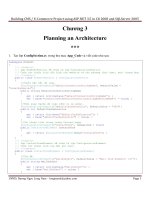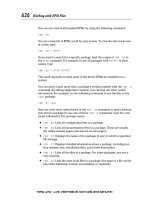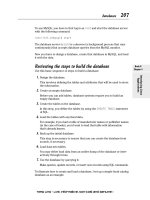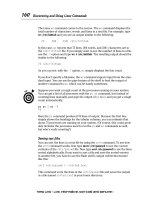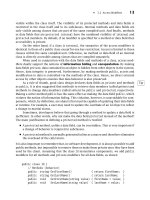TCP/IP Sockets in C# Practical Guide for Programmers phần 3 doc
Bạn đang xem bản rút gọn của tài liệu. Xem và tải ngay bản đầy đủ của tài liệu tại đây (101.78 KB, 19 trang )
26 Chapter 2: Basic Sockets
■
handle a client, it calls AcceptTcpClient(), which blocks until an incoming con-
nection is made to the TcpListener’s port. AcceptTcpClient() then returns an
instance of TcpClient that is already connected to the remote socket and ready for
reading and writing (we also could have used the AcceptSocket() method instead).
■
Get NetworkStream: line 36
The TcpClient method GetStream() returns an instance of a NetworkStream, which
is used for reading and writing to its socket.
■
Receive and repeat data until the client closes: lines 39–45
The while loop repeatedly reads bytes from the NetworkStream and immediately
writes them back to the stream until the client closes the connection, which is
indicated by a return value of 0 from Read(). The Read() method takes a byte array,
an offset at which to begin placing bytes, and an integer indicating the maximum
number of bytes to be placed in the array. It blocks until data is available and
returns the number of bytes actually placed in the array (which may be less than
the specified maximum). If the other end closes the connection before any bytes
have been received, Read() returns 0.
The Write() method of NetworkStream similarly takes three parameters and
transmits the specified number of bytes from the given array, beginning at the
specified offset (in this case, 0). There is another form of Write() that only takes
a byte array argument and transmits all the bytes contained therein to the other
end of the TCP connection; if we had used that form, we might have transmited
bytes that were not received from the client!
Any parameter inconsistencies (e.g., offset or length greater than the actual
length of the bytes array) result in an exception being thrown.
■
Close the client stream and socket: lines 48–49
Close the NetworkStream and the TcpClient socket.
■
Exception handling: lines 51–54
A server should be robust enough to handle a malfunctioning or malicious client
without crashing. Any exception that occurs during processing is caught here and
written to the console. The NetworkStream and its underlying socket are closed to
clean up. Note that this catch block is within the for loop, so after handling the
exception the loop continues and another client can be serviced.
TcpListener Summary
Description
TcpListener listens for connections from TCP network clients. The constructor
takes the local interface and optionally the local port to listen on. The Start()
method begins listening for incoming connection requests. The AcceptTcpClient()
and AcceptSocket() methods accept incoming connections and return a TcpClient
■
2.3 TCP Sockets 27
or Socket instance, respectively, that is already connected to the remote client and
ready for sending and receiving. The Stop() method stops listening for connections
and closes the TcpListener.
Constructors
public TcpListener(int port);
(obsoleted in 1.1 .NET SDK)
public TcpListener(IPEndPoint localEP);
public TcpListener(IPAddress address, int port);
The constructor has three forms: port only, IPEndPoint instance, or IPAddress and
port. When an address is specified it represents the local interface to listen on. Note
that starting in .NET 1.1, the local interface is required and the port-only constructor
is deprecated. Throws ArgumentNullException, ArgumentOutOfRangeException.
Selected Methods
public Socket AcceptSocket();
Accepts a pending connection request and returns a Socket used to send and receive
data. Throws InvalidOperationException.
public TcpClient AcceptTcpClient();
Accepts a pending connection request and returns a TcpClient used to send and
receive data. Throws InvalidOperationException.
public bool Pending();
Returns true if there are pending incoming connections that can be accepted. Throws
InvalidOperationException.
public void Start();
Start initializes the underlying socket, binds it, and begins listening for network
requests. Throws SocketException.
public void Stop();
Stops listening for incoming connections and closes the TcpListener. Any accepted
TcpClient or Socket instances should be closed separately. Throws SocketException.
Selected Properties
public EndPoint LocalEndpoint {get;}
Gets the underlying local bound EndPoint.
protected Socket Server {get;
}
Gets the underlying network Socket. Since this is a protected property, it can only
be accessed by classes that extend TcpListener. This is useful for accessing socket
options that are not directly accessible from the TcpListener API.
28 Chapter 2: Basic Sockets
■
2.3.3 Streams
As illustrated by the preceding examples, the primary paradigm for I/O in the .NET frame-
work is the stream abstraction. A stream is simply an ordered sequence of bytes. .NET
streams support both reading and writing bytes to a stream. In our TCP client and server,
each TcpClient or TcpListener instance holds a NetworkStream instance. When we write
to the stream of a TcpClient, the bytes can (eventually) be read from the stream of the
TcpListener at the other end of the connection. The Socket and UdpClient classes use
byte arrays instead of streams to send and receive data. If there is an error reading or
writing, a NetworkStream will throw an IOException. See Section 3.2 for more details on
streams.
NetworkStream
Description
NetworkStream is a subclass of Stream, and provides the underlying stream of data
for network I/O.
Selected Methods
public virtual void Close();
The Close() method closes the NetworkStream and closes the underlying socket if it
owns it.
public abstract int Read(byte[] buffer, int offset, int length);
The Read() method reads data from the network stream into the byte buffer argu-
ment. The offset within the buffer and number of bytes to read are also specified.
Read() returns the number of bytes read. Throws ArgumentNullException, Argument-
Exception, IOException.
public abstract void Write(byte[] buffer, int offset, int length);
The Write() method sends the contents of a supplied byte buffer argument to the net-
work. An offset within the byte buffer and number of bytes to write are also supplied
as arguments. Throws ArgumentNullException, ArgumentException, IOException.
Selected Properties
public virtual bool DataAvailable { get; }
Returns true if data is available to read on the stream, false if there is no data
available to read.
■
2.4 UDP Sockets 29
2.4 UDP Sockets
UDP provides an end-to-end service different from that of TCP. In fact, UDP performs only
two functions: (1) it adds another layer of addressing (ports) to that of IP, and (2) it detects
data corruption that may occur in transit and discards any corrupted messages. Because
of this simplicity, UDP sockets have some characteristics that are different from the TCP
sockets we saw earlier. For example, UDP sockets do not have to be connected before
being used. Where TCP is analogous to telephone communication, UDP is analogous to
communicating by mail: You do not have to “connect” before you send the package or
letter, but you do have to specify the destination address for each one. Similarly, each
message—called a datagram—carries its own address information and is independent of
all others. In receiving, a UDP socket is like a mailbox into which letters or packages from
many different sources can be placed. As soon as it is created, a UDP socket can be used
to send/receive messages to/from any address and to/from many different addresses in
succession.
Another difference between UDP sockets and TCP sockets is the way in which they
deal with message boundaries: UDP sockets preserve them. This makes receiving an appli-
cation message simpler, in some ways, than it is with TCP sockets (this is discussed further
in Section 2.4.3). A final difference is that the end-to-end transport service UDP provides its
best effort: There is no guarantee that a message sent via a UDP socket will arrive at its des-
tination, and messages can be delivered in a different order than they were sent (just like
letters sent through the mail). A program using UDP sockets must therefore be prepared
to deal with loss and reordering. (We’ll provide an example of this in Section 2.5.4.)
Given this additional burden, why would an application use UDP instead of TCP?
One reason is efficiency. If the application exchanges only a small amount of data—say, a
single request message from client to server and a single response message in the other
direction—TCP’s connection establishment phase at least doubles the number of messages
(and the number of round-trip delays) required for the communication. Another reason
is flexibility. When something other than a reliable byte-stream service is required, UDP
provides a minimal overhead platform on which to implement whatever is needed.
The .NET framework provides UDP sockets functionality using the class UdpClient,
or Socket for more advanced options. The UdpClient class allows for both sending and
receiving of UDP packets, and can be used to construct both a UDP client and server.
2.4.1 UDP Client
A UDP client begins by sending a datagram to a server that is passively waiting to be
contacted. The typical UDP client goes through three steps:
1. Construct an instance of UdpClient, optionally specifying the local address and port.
2. Communicate by sending and receiving datagrams (byte arrays) using the Send() and
Receive() methods of UdpClient.
3. When finished, deallocate the socket using the Close() method of UdpClient.
30 Chapter 2: Basic Sockets
■
Unlike a TcpClient,aUdpClient does not have to be constructed (or connected) with
a specific destination address. This illustrates one of the major differences between TCP
and UDP. A TCP socket is required to establish a connection with another TCP socket on
a specified host and port before any data can be exchanged, and, thereafter, it only com-
municates with that socket until it is closed. A UDP socket, on the other hand, is not
required to establish a connection before communication, and each datagram can be sent
and received from a different destination. The Connect() method of UdpClient does allow
the specification of the remote address and port, but its use is optional. Unlike the TCP
version of Connect(), the UDP version merely sets the default destination and does not
actually cause any connection-setup messages to be transmitted through the network.
Our UDP echo client, UdpEchoClient.cs, sends a datagram containing the string to
be echoed and prints whatever it receives back from the server. A UDP echo server simply
repeats each datagram that it receives back to the client. Of course, a UDP client only
communicates with a UDP server. Many systems include a UDP echo server for debugging
and testing purposes, or you can run the UDP echo server example from the next section.
UdpEchoClient.cs
0 using System; // For String, Int32, Console
1 using System.Text; // For Encoding
2 using System.Net; // For IPEndPoint
3 using System.Net.Sockets; // For UdpClient, SocketException
4
5 class UdpEchoClient {
6
7 static void Main(string[] args) {
8
9 if ((args.Length < 2) || (args.Length > 3)) { // Test for correct # of args
10 throw new System.ArgumentException("Parameters: <Server> <Word> [<Port>]");
11 }
12
13 String server = args[0]; // Server name or IP address
14
15 // Use port argument if supplied, otherwise default to 7
16 int servPort = (args.Length == 3) ? Int32.Parse(args[2]) : 7;
17
18 // Convert input String to an array of bytes
19 byte[] sendPacket = Encoding.ASCII.GetBytes(args[1]);
20
21 // Create a UdpClient instance
22 UdpClient client = new UdpClient();
23
■
2.4 UDP Sockets 31
24 try {
25 // Send the echo string to the specified host and port
26 client.Send(sendPacket, sendPacket.Length, server, servPort);
27
28 Console.WriteLine("Sent {0} bytes to the server ", sendPacket.Length);
29
30 // This IPEndPoint instance will be populated with the remote sender’s
31 // endpoint information after the Receive() call
32 IPEndPoint remoteIPEndPoint = new IPEndPoint(IPAddress.Any, 0);
33
34 // Attempt echo reply receive
35 byte[] rcvPacket = client.Receive(ref remoteIPEndPoint);
36
37 Console.WriteLine("Received {0} bytes from {1}: {2}",
38 rcvPacket.Length, remoteIPEndPoint,
39
Encoding.ASCII.GetString(rcvPacket, 0, rcvPacket.Length));
40 } catch (SocketException se) {
41 Console.WriteLine(se.ErrorCode + ": " + se.Message);
42 }
43
44 client.Close();
45 }
46 }
UdpEchoClient.cs
1. Application setup and parameter parsing: lines 9–19
■
Convert argument to bytes: lines 17–19
2. UDP socket creation: lines 21–22
This instance of UdpClient can send datagrams to any UDP socket. The destination
host and port can be set in the constructor, in the Connect() call, or directly in the
Send() call. In this case we set it in the Send() call. If we specify a host name, it is
converted to an IP address for us.
3. Send the datagram and receive the response: lines 24–42
■
Send the datagram: lines 25–26
The Send() call takes the datagram byte array and the number of bytes to send
as arguments. Send() can also take optional arguments specifying the destina-
tion address and port (either as a string host name/IP and integer port, or as an
IPEndPoint instance). If the destination arguments are omitted, they must have
been specified in either the UdpClient constructor or the Connect() call. If you do
not include the destination arguments in the constructor or Connect(), you can
32 Chapter 2: Basic Sockets
■
make subsequent calls to Send() with different destinations. However, if you
do specify destination arguments in the constructor or Connect(), you cannot
override the destination in the Send(), and attempting to do so will generate an
InvalidOperationException.
■
Create a remote IP end point for receiving: lines 30–32
The IPEndPoint class specifies an address and port combination. This IPEndPoint
instance will be passed as a reference to the Receive() method, which will populate
it with the remote sender’s IP address and port information.
■
Handle datagram reception: lines 34–35
Receive() blocks until it receives a datagram. When it returns, the remoteIPEnd-
Point instance will contain the address and port information for the remote host
that sent the packet just received.
4. Print reception results: lines 37–39
5. Close the socket: line 44
We invoke the UDP client using the same parameters as used in the TCP client:
C:\> UdpEchoClient 169.1.1.2 "Echo this!"
Sent 10 bytes to the server
Received 10 bytes from 169.1.1.2: Echo this!
One consequence of using UDP is that datagrams can be lost. In the case of our echo
protocol, either the echo request from the client or the echo reply from the server may
be lost in the network. Recall that our TCP echo client sends an echo string and then
blocks with a Read() waiting for a reply. If we try the same strategy with our UDP echo
client and the echo request datagram is lost, our client will block forever on Receive().
To avoid this problem, our client can implement a timeout on the blocking Receive()
call. In Section 2.5.4 we introduce UdpEchoClientTimeoutSocket.cs, which modifies
UdpEchoClient.cs to do just that.
2.4.2 UDP Server
Like a TCP server, a UDP server’s job is to set up a communication endpoint and passively
wait for the client to initiate the communication; however, since UDP is connectionless,
UDP communication is initiated by a datagram from the client, without going through
a connection setup as in TCP. This means receiving a datagram as a server is really no
different from receiving a datagram as a client. As a result, instead of separate classes
for a UDP client and server, the UdpClient class is used to implement the server as well as
the client.
The typical UDP server goes through four steps:
1. Construct an instance of UdpClient, specifying the local port. The server is now ready
to receive datagrams from any client.
■
2.4 UDP Sockets 33
2. Receive a packet using the Receive() method of UdpClient. The Receive() method
takes a reference to an IPEndPoint instance as an argument, and when the call returns
the IPEndPoint contains the client’s address so we know where to send the reply.
3. Communicate by sending and receiving datagram packets using the Send() and
Receive() methods of UdpClient.
4. When finished, deallocate the socket using the Close() method of UdpClient.
Our next program example, UdpEchoServer.cs, implements the UDP version of the
echo server. The server is very simple: it loops forever, receiving datagrams and then
sending the same datagrams back to the client.
UdpEchoServer.cs
0 using System; // For Console, Int32, ArgumentException, Environment
1 using System.Net; // For IPEndPoint
2 using System.Net.Sockets; // For UdpClient, SocketException
3
4 class UdpEchoServer {
5
6 static void Main(string[] args) {
7
8 if (args.Length > 1) { // Test for correct # of args
9 throw new ArgumentException("Parameters: <Port>");
10 }
11
12 int servPort = (args.Length == 1) ? Int32.Parse(args[0]) : 7;
13
14 UdpClient client = null;
15
16 try {
17 // Create an instance of UdpClient on the port to listen on
18 client = new UdpClient(servPort);
19 } catch (SocketException se) {
20 Console.WriteLine(se.ErrorCode + ": " + se.Message);
21 Environment.Exit(se.ErrorCode);
22 }
23
24 // Create an IPEndPoint instance that will be passed as a reference
25 // to the Receive() call and be populated with the remote client info
26 IPEndPoint remoteIPEndPoint = new IPEndPoint(IPAddress.Any, 0);
27
28 for (;;) { // Run forever, receiving and echoing datagrams
29 try {
34 Chapter 2: Basic Sockets
■
30 // Receive a byte array with echo datagram packet contents
31 byte[] byteBuffer = client.Receive(ref remoteIPEndPoint);
32 Console.Write("Handling client at " + remoteIPEndPoint+"-");
33
34 // Send an echo packet back to the client
35 client.Send(byteBuffer, byteBuffer.Length, remoteIPEndPoint);
36 Console.WriteLine("echoed {0} bytes.", byteBuffer.Length);
37 } catch (SocketException se) {
38 Console.WriteLine(se.ErrorCode + ": " + se.Message);
39 }
40 }
41 }
42 }
UdpEchoServer.cs
1. Application setup and parameter parsing: lines 8–14
UdpEchoServer takes a single optional parameter, the local port of the echo server
socket. The default port used is 7.
2. Create a UdpClient instance: lines 16–22
Unlike our UDP client program, a UDP server must explicitly set its local port to a num-
ber known by the client; otherwise, the client will not know the destination port for its
echo request datagram. This version of the constructor can throw a SocketException
if there is an error when accessing the socket or an ArgumentOutOfRangeException
if the port is not within the valid range.
3. Create an IPEndPoint instance: lines 24–26
The IPEndPoint class specifies an address and port combination. This IPEndPoint
instance will be passed as a reference to the Receive() method, which will populate
it with the remote sender’s IP address and port information.
4. Iteratively handle echo request datagrams: lines 28–40
The UDP server uses a single UdpClient (and hence a single underlying socket) for
all communication, unlike the TCP server which creates a new socket with every
successful AcceptTcpClient() or AcceptSocket().
■
Receive echo request: line 31
The Receive() method of UdpClient blocks until a datagram is received from a
client (unless a timeout is set). There is no connection, so each datagram may be
from a different sender. We receive the incoming packet into a byte array that will
also be used to send the echo reply. When the call to Receive() returns, the ref-
erence to the IPEndPoint instance is populated with the source’s (client’s) address
and port information.
■
2.4 UDP Sockets 35
■
Send echo reply: line 35
byteBuffer already contains the echo string and remoteIPEndPoint already contains
the echo reply destination address and port, so the Send() method of UdpClient
can simply transmit the datagram previously received.
UdpClient
Description
Provides User Datagram Protocol (UDP) network services.
Selected Constructors
public UdpClient();
public UdpClient(int port);
public UdpClient(IPEndPoint localEP);
public UdpClient(string host name, int port);
Creates a new instance of the UdpClient class. The UdpClient constructor has
optional arguments for the port, a local interface to bind to (IPEndPoint), or the server
to connect to (string host name/IP and integer port). If the destination is not set in
the constructor, it must be set either in a Connect() call or in the Send() method.
Throws ArgumentNullException, ArgumentException, SocketException.
Selected Methods
public void Close();
Closes the UDP connection. Throws SocketException.
public void Connect(IPEndPoint endPoint);
public void Connect(IPAddress addr, int port);
public void Connect(string host name, int port);
Connect() sets the default destination for this UdpClient. This call is optional.
Throws ArgumentNullException, ArgumentOutOfRangeException, SocketException,
ObjectDisposedException.
public byte[] Receive(ref IPEndPoint remoteEP);
Returns a UDP datagram sent by a remote host as an byte array and populates the
IPEndPoint reference with the endpoint information for the sending remote host.
Throws SocketException, ObjectDisposedException.
public int Send(byte[] dgram, int length);
public int Send(byte[] dgram, int length, IPEndPoint endPoint);
36 Chapter 2: Basic Sockets
■
public int Send(byte[] dgram, int length, string host name, int port);
Sends a UDP datagram to a remote host. The datagram to send is specified by the
byte array argument and the number of bytes to send integer argument. Optional
arguments can be included to specify the datagram destination, either using an
IPEndPoint instance, or a string host name/IP address and integer port argument. If
no default destination has been specified by the UdpClient constructor or Connect()
method, the destination is not optional. If a default destination has been set in
the constructor or Connect(), you may not use different destination arguments
in the Send() call. Returns the number of bytes sent. Throws ArgumentException,
InvalidOperationException, SocketException, ObjectDisposedException.
Selected Properties
protected Socket Client {get; set;}
Gets or sets the underlying network socket. Since this is a protected property, it can
only be accessed by classes that extend UdpClient. This is useful for accessing socket
options that are not directly accessible from the UdpClient API.
2.4.3 Sending and Receiving with UDP Sockets
A subtle but important difference between TCP and UDP is that UDP preserves message
boundaries. Each call to UdpClient.Receive() returns data from at most one call to
UdpClient.Send(). Moreover, different calls to UdpClient.Receive() will never return
data from the same call to UdpClient.Send().
When a call to Write() on a TCP socket’s stream returns, all the caller knows is that
the data has been copied into a buffer for transmission; the data may or may not have
actually been transmitted yet (this is covered in more detail in Chapter 5). UDP, however,
does not provide recovery from network errors and, therefore, does not buffer data for
possible retransmission. This means that by the time a call to Send() returns, the message
has been passed to the underlying channel for transmission and is (or soon will be) on its
way out the door.
Between the time a message arrives from the network and the time its data is returned
via Read() or Receive(), the data is stored in a first-in, first-out (FIFO) queue of received
data. With a connected TCP socket, all received-but-not-yet-delivered bytes are treated
as one continuous sequence of bytes (see Chapter 5). For a UDP socket, however, the
received data may have come from different senders. A UDP socket’s received data is kept
in a queue of messages, each with associated information identifying its source. A call to
Receive() will never return more than one message. The maximum amount of data that
can be transmitted by a UdpClient is 65,507 bytes—the largest payload that can be carried
in a UDP datagram.
■
2.5 The .NET Socket Class 37
2.5 The .NET Socket Class
The .NET Framework provides a Socket class that is a wrapper around the WinSock imple-
mentation. Since TcpClient, TcpListener, and UdpClient all utilize the Socket class for
their own implementations, Socket contains all the functionality of those classes, plus
much more. The Socket interface is a generic API that actually covers more than just IP,
and as such exploring all of the functionality it provides is beyond the scope of this book.
In this section we introduce its usage for TCP and UDP and walk through some common
cases where you might use it.
2.5.1 TCP Client with Socket
For a TCP client to use the Socket class, it will perform the following steps:
1. Call the Socket constructor: The constructor specifies the address type, socket
type, and protocol type.
2. Call the Socket Connect() method: Connect() takes an IPEndPoint argument that
represents the server to connect to.
3. Send and receive data: Using the Socket Send() and Receive() calls.
4. Close the socket: Using the Socket Close() method.
Here we present a version of the TcpEchoClient.cs program that uses the Socket
class instead of the TcpClient class.
TcpEchoClientSocket.cs
0 using System; // For String, Int32, Console, ArgumentException
1 using System.Text; // For Encoding
2 using System.IO; // For IOException
3 using System.Net.Sockets; // For Socket, SocketException
4 using System.Net; // For IPAddress, IPEndPoint
5
6 class TcpEchoClientSocket {
7
8 static void Main(string[] args) {
9
10 if ((args.Length < 2) || (args.Length > 3)) { // Test for correct # of args
11 throw new ArgumentException("Parameters: <Server> <Word> [<Port>]");
12 }
13
14 String server = args[0]; // Server name or IP address
15
38 Chapter 2: Basic Sockets
■
16 // Convert input String to bytes
17 byte[] byteBuffer = Encoding.ASCII.GetBytes(args[1]);
18
19 // Use port argument if supplied, otherwise default to 7
20 int servPort = (args.Length == 3) ? Int32.Parse(args[2]) : 7;
21
22 Socket sock = null;
23
24 try {
25 // Create a TCP socket instance
26 sock = new Socket(AddressFamily.InterNetwork, SocketType.Stream,
27 ProtocolType.Tcp);
28
29 // Creates server IPEndPoint instance. We assume Resolve returns
30 // at least one address
31
IPEndPoint serverEndPoint = new IPEndPoint(Dns.Resolve(server).AddressList[0],
32 servPort);
33 // Connect the socket to server on specified port
34 sock.Connect(serverEndPoint);
35 Console.WriteLine("Connected to server sending echo string");
36
37 // Send the encoded string to the server
38 sock.Send(byteBuffer, 0, byteBuffer.Length, SocketFlags.None);
39
40 Console.WriteLine("Sent {0} bytes to server ", byteBuffer.Length);
41
42 int totalBytesRcvd = 0; // Total bytes received so far
43 int bytesRcvd = 0; // Bytes received in last read
44
45 // Receive the same string back from the server
46 while (totalBytesRcvd < byteBuffer.Length) {
47 if ((bytesRcvd = sock.Receive(byteBuffer, totalBytesRcvd,
48 byteBuffer.Length - totalBytesRcvd, SocketFlags.None)) == 0) {
49 Console.WriteLine("Connection closed prematurely.");
50 break;
51 }
52 totalBytesRcvd += bytesRcvd;
53 }
54
55
Console.WriteLine("Received {0} bytes from server: {1}", totalBytesRcvd,
56 Encoding.ASCII.GetString(byteBuffer, 0, totalBytesRcvd));
57
58 } catch (Exception e) {
■
2.5 The .NET Socket Class 39
59 Console.WriteLine(e.Message);
60 } finally {
61 sock.Close();
62 }
63 }
64 }
TcpEchoClientSocket.cs
1. Setup and parameter parsing: lines 10–22
2. TCP Socket constructor: lines 25–27
The Socket constructor takes three arguments:
■
The address family: Set to AddressFamily.InterNetwork for IP.
■
The socket type: Indicates stream or datagram semantics and is set to Socket-
Type.Stream for TCP or SocketType.Dgram for UDP.
■
The protocol type: Set to ProtocolType.Tcp or ProtocolType.Udp.
3. Connect to the server: lines 29–35
The Connect() method takes an IPEndPoint instance, which we have constructed
from the arguments to the program using IPAddress.Parse(). If the connection fails
a SocketException will be thrown.
4. Send the string to the echo server: lines 37–38
The Socket class has several Send() methods that take different combination of
parameters, always including a byte array containing the data to be transmitted.
Here we use a version that takes (1) the byte buffer containing the data to be sent,
(2) the byte offset into the buffer where the data to be sent starts, (3) a total number
of bytes to send, and (4) any socket flag settings. Socket flags are beyond the scope
of this book, and in this case are set to SocketFlags.None.
5. Receive the reply from the echo server: lines 45–53
Since we know the number of bytes to expect from the echo server, we can repeatedly
receive bytes until we have received the same number of bytes that we sent. The
Receive() method can be called in several forms; here we use the one that takes
four parameters: (1) buffer to receive to, (2) byte offset into the buffer where the
first byte received should be placed, (3) the maximum number of bytes to be placed
in the buffer, and (4) the socket flags parameter. The loop and data receive logic are
identical to those in the earlier TcpClient example.
6. Print echoed string: lines 55–56
7. Error handling and socket close: lines 58–62
40 Chapter 2: Basic Sockets
■
2.5.2 TCP Server with Socket
For a TCP server to use the Socket class, it will perform the following steps:
1. Call the Socket constructor: The constructor specifies the address type, socket
type, and protocol type.
2. Call the Socket Bind() method: Bind() associates the socket with a local address
and port number.
3. Call the Socket Listen() method: Listen() takes an integer argument represent-
ing the number of connections allowed to queue, and starts listening for incoming
connections.
4. Repeatedly:
■
Call the Socket Accept() method to accept an incoming connection: Accept()
takes no arguments and returns a Socket instance representing the remote client
socket.
■
Receive and send data: Using the accepted client Socket instance, use its
Receive() and Send() methods to transfer data.
■
Close the client socket: Using the Socket Close() method.
5. Close the server socket: Using the Socket Close() method.
Here we present a version of the TcpEchoServer.cs program that uses the Socket
class instead of the TcpListener and TcpClient classes.
TcpEchoServerSocket.cs
0 using System; // For Console, Int32, ArgumentException, Environment
1 using System.Net; // For IPAddress
2 using System.Net.Sockets; // For TcpListener, TcpClient
3
4 class TcpEchoServerSocket {
5
6 private const int BUFSIZE = 32; // Size of receive buffer
7 private const int BACKLOG = 5; // Outstanding connection queue max size
8
9 static void Main(string[] args) {
10
11 if (args.Length > 1) // Test for correct # of args
12 throw new ArgumentException("Parameters: [<Port>]");
13
14 int servPort = (args.Length == 1) ? Int32.Parse(args[0]): 7;
15
■
2.5 The .NET Socket Class 41
16 Socket server = null;
17
18 try {
19 // Create a socket to accept client connections
20 server = new Socket(AddressFamily.InterNetwork, SocketType.Stream,
21 ProtocolType.Tcp);
22
23 server.Bind(new IPEndPoint(IPAddress.Any, servPort));
24
25 server.Listen(BACKLOG);
26 } catch (SocketException se) {
27 Console.WriteLine(se.ErrorCode + ": " + se.Message);
28 Environment.Exit(se.ErrorCode);
29 }
30
31 byte[] rcvBuffer = new byte[BUFSIZE]; // Receive buffer
32 int bytesRcvd; // Received byte count
33
34 for (;;) { // Run forever, accepting and servicing connections
35
36 Socket client = null;
37
38 try {
39 client = server.Accept(); // Get client connection
40
41 Console.Write("Handling client at " + client.RemoteEndPoint+"-");
42
43 // Receive until client closes connection, indicated by 0 return value
44 int totalBytesEchoed = 0;
45 while ((bytesRcvd = client.Receive(rcvBuffer, 0, rcvBuffer.Length,
46 SocketFlags.None)) > 0) {
47 client.Send(rcvBuffer, 0, bytesRcvd, SocketFlags.None);
48 totalBytesEchoed += bytesRcvd;
49 }
50 Console.WriteLine("echoed {0} bytes.", totalBytesEchoed);
51
52 client.Close(); // Close the socket. We are done with this client!
53
54 } catch (Exception e) {
55 Console.WriteLine(e.Message);
56 client.Close();
57 }
58 }
42 Chapter 2: Basic Sockets
■
59 }
60 }
TcpEchoServerSocket.cs
1. Application setup and parameter parsing: lines 11–16
2. Call the Socket constructor: lines 19–21
The Socket constructor takes three arguments:
■
The address family: Set to AddressFamily.InterNetwork for IP.
■
The socket type: Indicates stream or datagram semantics and is set to Socket-
Type.Stream for TCP or SocketType.Dgram for UDP.
■
The protocol type: Set to ProtocolType.Tcp or ProtocolType.Udp.
3. Bind the socket: line 23
The Bind() method is called with a IPEndPoint instance containing IPAddress.Any
(0.0.0.0) and the specified server port number. The bind assigns the socket a local
address and port and throws a SocketException if it fails to do so (e.g., if the local
endpoint is already in use).
4. Listen for incoming connections: line 25
The Listen() method causes the socket to begin handling incoming TCP connec-
tion requests and queuing them for acceptance by our program. It takes an integer
argument that specifies the backlog, which is the maximum number of outstanding
connections allowed in the queue. The valid values for the backlog are typically 1–5,
but may vary by system; check your documentation.
5. Loop forever, iteratively handling incoming connections: lines 34–58
■
Accept an incoming connection: line 39
The server Socket instance supplies new, connected client Socket instances for
each new TCP connection. When the server is ready to handle a client, it calls
Accept(), which blocks until an incoming connection is made to the server Socket’s
port. Accept() then returns an instance of Socket that is already connected to the
remote socket and ready for reading and writing.
■
Output the remote end point being serviced: line 41
One feature of Socket that is not available with TcpClient is the ability to access
the RemoteEndPoint property and determine the IP address and port of the client
connection.
■
Receive and repeat data until the client closes: lines 43–50
The while loop repeatedly reads bytes (when available) from the Socket and
immediately writes the same bytes back to the stream until the client closes the
connection. The loop and data transfer logic are identical to the TcpClient version.
■
2.5 The .NET Socket Class 43
■
Close the client socket: line 52
■
Exception handling: lines 54–57
Socket
Description
The Socket class is a wrapper around the WinSock sockets API. Using a Socket
involves the following steps:
1. Create a Socket instance with the socket constructor.
2. If the Socket is a server, call Bind() to assign a local endpoint.
3. If the Socket is a client, call Connect() to connect to a remote endpoint.
4. If the Socket is a server, call Listen() to begin listening for connections, and call
Accept() to retrieve an incoming connection.
5. Use the Send() and Receive() methods to transfer data over TCP, or SendTo() and
ReceiveFrom() for UDP.
6. Call Shutdown() to disable the socket.
7. Call Close() to close the socket.
Constructor
public Socket(AddressFamily, SocketType, ProtocolType);
Creates a new instance of the Socket class. Each argument is specified by its own
enumeration class, AddressFamily, SocketType, and ProtocolType. For the purposes
of this book, the AddressFamily is set to InterNetwork, the SocketType is set to
Stream for TCP semantics or Dgram for UDP semantics, and the ProtocolType is set to
Tcp for TCP and Udp for UDP.
Selected Methods
public void Bind(EndPoint localEP);
Associates a Socket with a local endpoint. Throws ArgumentNullException, Socket-
Exception, ObjectDisposedException.
public void Close();
Closes a Socket connection.
public void Connect(EndPoint remoteEP);
Establishes a connection to a remote server. Throws ArgumentNullException, Socket-
Exception, ObjectDisposedException.
44 Chapter 2: Basic Sockets
■
public object GetSocketOption(SocketOptionLevel, SocketOptionName);
public void GetSocketOption(SocketOptionLevel, SocketOptionName, byte[]);
public byte[] GetSocketOption(SocketOptionLevel, SocketOptionName, int);
Returns the value of the specified Socket option in an object or in an array of bytes.
The complete list of properties available for SocketOptionLevel and SocketOption-
Name are detailed in their respective class descriptions following this class. Throws
SocketException, ObjectDisposedException.
public void Listen( int backlog);
Changes the Socket state to handle incoming TCP connections and queue them
to be accepted by the program. The backlog specifies the maximum number of
incoming connections that can be queued at any time. The normal backlog values
are 1–5 but vary by system; check your documentation. Throws SocketException,
ObjectDisposedException.
public bool Poll(int microseconds, SelectMode mode);
Checks the status of a Socket. The first argument specifies the number of micro-
seconds to wait for a response. A negative value indicates blocking indefinitely.
The status checked depends on the SelectMode enumeration argument. Select-
Mode.SelectRead checks for readability. SelectMode.SelectWrite checks for write-
ability. SelectMode.SelectError checks for the existence of an error.
public int Receive(byte[] buffer);
public int Receive(byte[] buffer, SocketFlags flags);
public int Receive
(byte[] buffer, int length, SocketFlags flags);
public int Receive(byte[] buffer, int offset, int length, SocketFlags flags);
Receives data from the Socket into the byte buffer argument. Optional arguments
include SocketFlags, an integer number of bytes to receive, and an integer offset in
the buffer. Returns the number of bytes received. Throws ArgumentNullException,
ArgumentOutOfRangeException, SocketException, ObjectDisposedException.
public int ReceiveFrom(byte[] buffer, ref EndPoint remoteEP);
public int ReceiveFrom(byte[] buffer, SocketFlags flags, ref EndPoint remoteEP);
public int ReceiveFrom(byte[] buffer, int length, SocketFlags flags, ref EndPoint
remoteEP);
public int ReceiveFrom(byte[] buffer, int offset, int length, SocketFlags flags,
ref EndPoint localEP);
Receives a UDP datagram into the byte buffer argument and populates the
End-
Point reference with the sender’s endpoint information. Optional arguments include
SocketFlags, an integer number of bytes to receive, and an integer offset in the
buffer. Returns the number of bytes received. Note that there is an important
difference between the byte buffer used to receive datagrams with a Socket and
a UdpClient. While the UdpClient returns a reference to preallocated buffer, the


